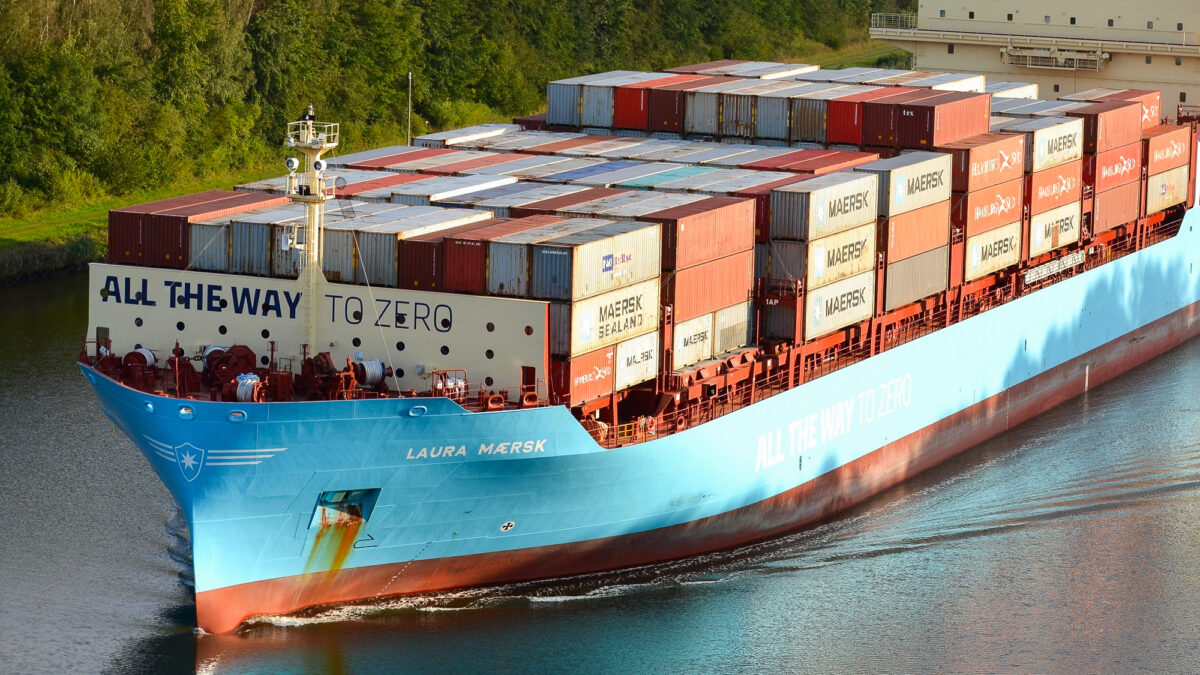The world’s second-largest marine shipping company has a massive, complex task ahead of it.
Danish shipping giant Maersk in February became the first company in its industry to commit to achieve net-zero status by 2040, validated by the Science Based Targets initiative.
It’s a massive, ambitious and logistically complex project: The marine shipping sector uses an estimated 300 million tons of fuel annually, making it responsible for approximately 3 percent of global emissions. A.P. Moller-Maersk (the company’s official name) is the world’s second largest maritime container shipping company, with more than $51 billion in 2023 revenues.
The company made three “near-term” pledges for 2030:
- Maersk hopes to slash its Scope 1 emissions by 35 percent, according to its latest sustainability report. This includes the footprint related to its own “financially” controlled operations, including terminal operations. For 2023, this was about 43 percent of the total.
- The company aspires to cut its Scope 2 emissions from purchased electricity for terminals and other buildings by 100 percent through renewable power sourcing.
- And it aims for a 22 percent reduction in Scope 3, the most complicated piece of its pledge. In 2023, this represented about 56 percent of emissions, covering upstream cargo transportation and distribution activities, use of sold products and marine fuel purchases, among other things.
Maersk is aiming for absolute cuts of more than 90 percent across all three categories to achieve net zero by 2040.
Maersk will rely on cooperation with its major clients — including Amazon, Nestle and Volvo — to deliver on its promises, according to Lene Bjørn Serpa, director, head of corporate sustainability and ESG at Maersk.
“I think it’s critical for us to work with customers because the green transition of the shipping industry is not something that any single company or actor in the industry can manage by ourselves.”
“I think it’s critical for us to work with customers because the green transition of the shipping industry is not something that any single company or actor in the industry can manage by ourselves,” Serpa said. “We have to work in partnership, we have to rely on demand from our customers.”
The company also has a 150-person Maersk Energy Transition team working on alternative fuels, she said.
Navigating thorny technical and policy challenges
This is the first time Maersk has set absolute targets, rather than ones that merely reduce the rate, or intensity, of its emissions. The cuts will be measured against 2022 — when Maersk had a carbon footprint of 82.38 million metric tons — rather than the year before, when the COVID pandemic brought supply chains to a halt, causing a sharp decrease in emissions. It reported a 4.1 percent reduction for 2023.
Maersk’s targets reflect a “well-to-wake” focus that considers emissions starting with fuel production through to what’s combusted in ship engines.
Shipping companies face multiple technical and jurisdictional challenges to meet the Paris Agreement goal of holding global temperature increases below 1.5 degrees Celsius. Two big ones: the scarcity and expense of alternative fuels and slow-to-emerge guidance from the International Maritime Organization, the United Nations agency responsible for steering the industry to net zero.
The IMO published a draft of a “possible net-zero framework” March 27, calling for a phase-down of marine fuels with higher emissions and proposing a carbon price on shipping activities to spur the adoption of lower-carbon alternatives, such as biodiesel and methanol. One possible approach is the “Green Balance Mechanism,” which would impose fees on fossil fuels and allocate that money to “green fuels,” so that the average price is equal.
Amazon, Volvo, Nestle sign up for Maersk’s ‘green fuels’
Maersk’s two biggest tools for reducing emissions are improved fuel efficiency, through more sophisticated route planning, and a transition to “green fuels,” which it defines as options that have 65 percent to 80 percent of the emissions of fossil fuels, according to its transition plan.
Maersk was the first shipping company to launch a methanol-powered vessel in fall 2023. It has 24 more on order for delivery between now and 2027, and is converting another ship to a dual-fuel methanol engine this year to “demonstrate that new builds are no longer the only pathway to decarbonization.”
“We found that there was significant demand from the customer’s side and a willingness to invest (…) with us in innovative pilots and ventures to determine what would be the green fuels of the future.”
The company created its Eco Delivery service line to spur adoption of low-emissions transportation options, including biodiesel and green methanol. Companies using the service can claim that they’re replacing legacy marine fuels with certified green alternatives. In exchange, they receive verified emissions-reduction certificates they can use for carbon accounting.
Eco Delivery covered 3 percent of Maersk’s ocean volumes during 2023, compared with 2 percent a year earlier. More than 200 companies have opted into the service, as of Maersk’s latest sustainability report.
Significant demand from customers for green alternatives
“We found that there was significant demand from the customer’s side and a willingness to invest — or you could say co-invest — with us in innovative pilots and ventures to determine what would be the green fuels of the future,” Serpa said.
Some customers, including Bestseller, Nestlé, Novo Nordisk and Volvo Cars cover 100 percent of their ocean freight via Eco Delivery. Amazon has used the option for four years; its latest contract will reduce 44,600 metric tons of emissions, or about 50 million pounds of coal burned.
Maersk is using green bonds to fund its purchases of new ships using green fuels, which it hopes will cover 25 percent of ocean shipments by 2030. A risk to that strategy is the scarcity of green methanol, which won’t be widely available for at least three years, according to an analysis by S&P Global.
This article originally appeared on GreenBiz.com as part of our partnership with GreenBiz Group, a media and events company that accelerates the just transition to a clean economy.


